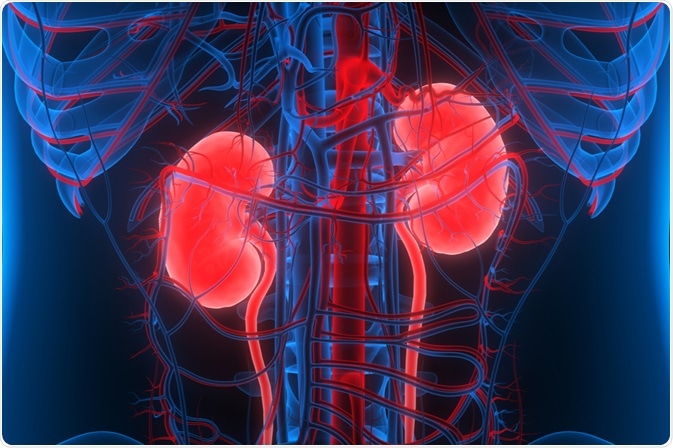When a patient presents with symptoms characteristic of nephrotic syndrome, a diagnosis can be made with a urinalysis test. Other tests, such as blood tests and a kidney biopsy, are also important to establish the cause of the condition, which will help guide treatment decisions for the patient.

Image Credit: Magic mine / Shutterstock
Presenting Symptoms
The first step to diagnose nephrotic syndrome is to have a consultation with the patient about their medical history and the presenting symptoms. Signs and symptoms that may be indicative of the condition include:
- Edema (e.g. puffy eyes and face, or swelling in the arms or legs)
- Foamy urine
- Loss of appetite
- Fatigue
- Unexplained weight gain
Urinalysis
A urinalysis provides important information about the content of the urine. Of particular importance for the diagnosis of nephrotic syndrome, a high concentration of protein in the urine can be detected with this test.
The dipstick test can detect the presence of albumin in a sample of urine. The sample is collected in a sterilized sample container and then analyzed for the presence of albumin with a strip of paper, known as a dipstick that has been chemically treated to change color at certain concentrations in the urine.
The 24-hour urine sample test is also commonly used to take an accurate measurement of the protein content in the urine over a 24-hour period. This typically involves collecting all urine excreted within a 24-hour period, which is then sent to a laboratory for analysis. Alternatively, the ratio of albumin to creatinine can be used to estimate the albumin level in a single urine sample.
A high concentration of protein in the urine is the characteristic sign of nephrotic syndrome that allows a diagnosis to be made. In adults, this is classified as more than 3.5g/17.73m2 surface area of the body per day, and in children as more than 40mg/m2 surface area of the body per hour.
Blood Tests
A common sign of nephrotic syndrome is low levels of albumin and other proteins in the blood referred to as hypoalbuminemia, which can be detected with a blood test.
Additionally, blood tests can be used to detect hypertriglyceridemia and hypercholesterolemia. High levels of both triglycerides and cholesterol in the blood are linked to nephrotic syndrome and may increase the risk of complications such as myocardial infarction. The serum creatinine and blood urea may also be measure as a way to monitor the overall function of the kidney.
Kidney Biopsy
A sample of the kidney tissue to be tested is often needed to confirm the diagnosis and cause of nephrotic syndrome. This involves the insertion of a special needle through the skin and into the kidney to take a small sample of the kidney tissue, which can then be sent to a laboratory for analysis. The procedure is usually carried out in a hospital environment with light sedation and local anesthetic.
Impact on Treatment Decisions
These diagnostic tests are important to help determine the underlying cause of the symptoms. There are various other health conditions that may lead to nephrotic syndrome, and an essential part of the diagnostic process is to narrow down the etiology. This information is instrumental in future treatment decisions, where the cause should be addressed to allow for optimal treatment outcomes.
References
Further Reading
Last Updated: Apr 8, 2021